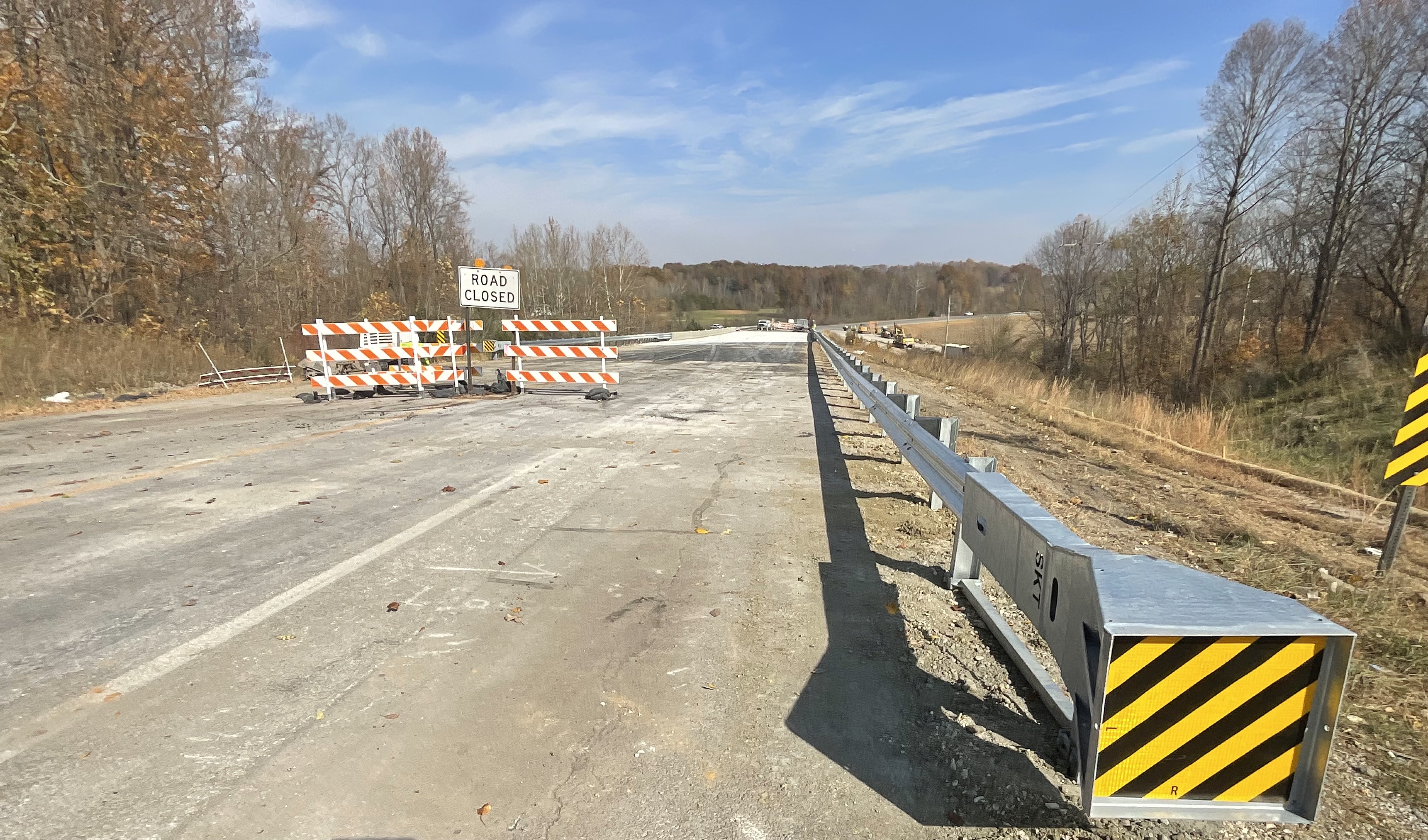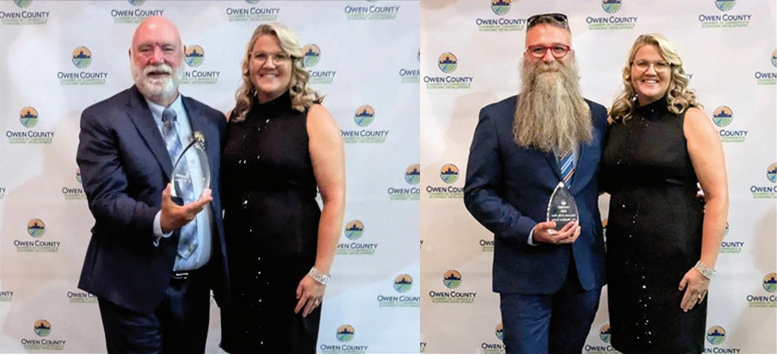The Environmental Protection Agency (EPA) has started remedial investigation into the Franklin Street Groundwater Contamination in Spencer.
The site was added to the national priorities list in May of 2018, but work to start the remedial investigation, the next step in the site milestones, did not start until last fall, with the testing starting earlier this year.
The contaminant tetrachloroethene (PCE) was first detected by Bean Blossom Patricksburg (BBP) Water Corporation in 2011 and has been completely removed from the treated water since 2017. Even at the initial detection the contaminnat’s levels were 1.2 parts per billion (ppb), which is under the maximum contaminant level set by the EPA at 5 ppb.
About PCE
PCE is also sometimes referred to as PERC.
According to the National Institutes of Health (NIH), PCE “is a manufactured chemical that is widely used for dry cleaning of fabrics and for metal-degreasing,” and “it appears as a clear colorless volatile liquid.”
PCE is both a known and probable carcinogen, and it can harm the nervous system.
“There’s no doubt that it’s toxic, and there’s lots of evidence for a variety of different kinds of toxic effects, chronic effects,” Paul Tratnyek, professor at Oregon Health and Science University’s School of Public Health said. “Any route of exposure to this stuff is not good for you, but it doesn’t have a lot of real acute toxicity.”
Tratnyek was connected to The Owen News through SciLine, a nonprofit service with the mission of enhancing the amount and quality of scientific evidence in news stories. They are based at the American Association for the Advancement of Science (AAAS). His expertise is in environmental chemistry, specifically in the remediation of contaminants and treatment for groundwater.
Tratnyek noted that the sensitivity and health impacts vary from person to person.
PCE is also a volatile organic compound.
“We call these volatile organic compounds because they're organic and volatile means they go from water to vapor pretty readily,” EPA Remedial Project Manager Dion Novak said during the April 18 community meeting about the Superfund site.
PCE can contaminate drinking water, indoor air quality through soil vapor intrusion and groundwater.
Drinking water
“We’re the ones that found the problem in the first place because we do annual water testing,” BBP CEO Todd Gardner said.
“Even though the finished water was under the guidelines set for the chemical [PCE] the BBP Water Corporation Board of Directors decided to be proactive and in 2014 designs for treating and removal of all PERC from the finished water was being engineered,” BBP’s 2022 annual water quality report said.
In addition to a new well being added, BBP added air strippers and reverse osmosis filtering units.
PCE has not been found in BBP’s finished water since the air strippers were turned on in May of 2017, completely removing it from the finished water.
“Even before then we weren’t using the well that had the contamination, so we never sent treated water that was contaminated. It was a well that wasn’t being used at the time that it popped up on,” Gardner said.
“We are proud to report that the water quality provided by BBP Water Corporation has met or exceeded the water quality standards established at the state and federal levels,” the report reads. “The BBP Water Corporation Board of Directors are all members of the water system. Our customers are our neighbors and relatives. BBP strives to produce the safest water possible for our customers.”
Tratnyek said that one of the challenges is for situations in which the drinking water from a private well has been contaminated with PCE.
“It’s a much trickier problem for those people to figure out if they can treat their own water sufficiently and reliably,” he said.
The necessary filters can often be cost prohibitive.
“The other thing that a lot of people forget about is that you don't have any way of knowing if they're working because you can't see PCE. You can’t smell it at low concentrations,” Tratnyek said. “The utility will pay somebody to test the water and make sure that there’s no PCE in the water, and then if there’s no PCE in the water, it’s fine. But if you’re a homeowner and you install an under the sink filter system to try to remove something like that from your well water, it’s up to you to try to get the water tested to make sure that the filter system is actually working. And that’s obviously not a desirable situation.”
Gardner said that he does not know of any individuals within the town of Spencer that have private wells used for drinking water.
Soil vapor intrusion
Novak explained soil vapor intrusion during the April community meeting.
“It’s not that dissimilar to how radon can get into your house from the soil,” Novak said. “This contamination can come up, can vaporize up through the soil and then into your building through a basement, through a crawl space. If you have a concrete slab, it can come up through cracks in the slab.”
The EPA tests for vapor intrusion sampling in both the spring and the winter.
“The contamination that’s underground can be different, depending on the season. Typically winter, because it’s colder, because everything’s closed up and your furnace is on, typically that’s more of a worst case scenario,” Novak said.
He explained that they will ask property owners and residents for permission and do the testing for free. Jacobs Engineering is contracted to do the work.
“If this first round of data [in the spring] shows us that there’s a problem with the air quality in your house, then EPA will come and install a mitigation system at no cost to you. And that mitigation system is very similar to how to get rid of radon in your house,” Novak said.
The mitigation system creates negative pressure below the structure to essentially blow the vapors outside where it dissipates and is no longer a concern.
Breathing in the vapors from PCE poses similar health risks as consuming it.
“The EPA is pretty good about addressing that kind of stuff, they have a very elaborate sort of protocol for figuring out whether a house or community is vulnerable to vapor intrusion problems,” Tratnyek said.
Groundwater
Tratnyek said that the best way to prevent drinking water contamination and soil vapor intrusion is to remove the contaminant from the groundwater to begin with. He said there is an abundance of companies that do this work.
“At the same time, though, it’s not always easy, and depending on the geology of the site, and a whole bunch of other factors, it can be hard to do it successfully. There are lots of different things you can do. But they don't all necessarily work either quickly or consistently or for a reasonable amount of money,” he said.
“The easiest types of sites to deal with are uniform beach sand. Because they're very predictable, so then it's relatively easy to know where the contamination is going and where it's hiding.”
When asked about the challenges posed by Karst topography during the April meeting, Novak said it does pose a potential challenge.
Tratnyek called it a complication.
“There are two other scenarios that are so famously the opposite [of the ease of beach sand]. One of them is fractured rock, and the other one is Karst. Karst is basically limestone, and it dissolves with water, and you get these little channels. So Karst is prone to what we call preferential flow, where the water is not moving through the pores so much as it's actually moving through little channels that are going to flow much faster than it is anywhere else in the aquifer. And those are totally unpredictable, we don't know where they are.”
He continued, “That makes predicting where the plume is going to go and how fast much trickier, and it also makes remediation trickier too because the contamination has a tendency to kind of slip by whatever you do to the system to try to cut off the contamination. It can kind of slip through these preferential flow paths, so it makes remediation harder.”
Tratnyek and Novak both said that there’s no way to estimate how far the groundwater contamination has spread.
“PCE is very mobile. It is happy to be dissolved in the water, and it will move with the groundwater. So if your groundwater is moving fast, the PCE will move pretty close to the same speed as the groundwater,” Tratnyek said. “If you've got a Karst situation where you have preferential flow, you have the possibility that PCE could move quite fast and quite far along some sort of preferential flow paths... The distances could be anywhere from a few hundred feet to considerably farther; it really depends on the situation. It really makes it very unpredictable.”
It made the questions from concerned citizens at the April meeting difficult for Novak to answer because of the early nature of the site’s investigation.
Tratnyek said that whether or not the groundwater’s contamination is spreading to surface water and into the White River depends on whether or not there is the presence of DNAPLs or dense nonaqueous phase liquids. This is, in essence, a pool of the contaminant that sits at the bottom of the aquifer.
“If there was DNAPL there, then that would suggest quite high concentrations of PCE, and that would be probably more concerning. On the other hand, if this is a dilute plume and the concentrations of PCE are low, by the time it gets out into the river, and you consider both all the dilution and the opportunity for volatilization losses, in the overall scheme of things, that's probably not the thing that would concern me the most,” he said. “If you think about it from a comparative risk point of view, I kind of don’t think that’s the biggest issue here.”
One citizen asked Novak if he would eat a sandwich made with produce, specifically tomatoes, grown within one of the targeted investigation areas. Novak said he would, and Tratnyek said it shouldn’t be a problem.
“Contaminated groundwater is far below that,” he said.
He noted that one method of cleaning groundwater is called phytoremediation.
“They would plant things like poplar trees that have deep roots, with the idea that they actually want the roots to go down to where the contamination is and basically pull the water up and bring up the contaminants while there,” Tratnyek said. “And it works. It's actually pretty popular and effective in some places. In that case, you would actually be mobilizing the PCE to the surface.”
Another complication
Tratnyek specifically cited concerns if there is the presence of DNAPLs or dense nonaqueous phase liquids, which are heavier than water and only slightly soluble in water.
“If there is, that makes the stakes much higher,” he said.
He related it to salad dressing – where the lighter, olive oil floats on top of the vinegar and doesn’t completely mix with the vinegar.
“What's different about PCE is, unlike oils, like gasoline and olive oil, it's heavier than water. It's not lighter than water. And so olive oil floats; gasoline floats; PCE sinks, hence the DNAPL. So if you spill a lot of pure phase PCE, it will sink into the aquifer, down to as far as it can go until it basically hits the bottom of something. And then you get a pool of organic liquid down there,” Tratnyek said. “The reason that’s a really big issue with respect to dealing with sites like this is that that provides essentially an infinite supply of dissolved PCE into the groundwater.”
While it makes the job of the environmental engineers more difficult, it also has an indirect impact on the general public.
“It’s down below. People are not directly connected to it, but it’s a source of the PCE that’s just sitting there, and it’s just bleeding off PCE into the water, and it will do that indefinitely until it's removed,” he said.
When asked about whether or not there has been a DNAPL found with this site, the EPA responded, “Chlorinated volatile organic compounds (CVOCs) are considered DNAPLs and are the primary reason this site came to EPA’s attention.”
Investigation progress
During the April meeting, the EPA said they’ve completed soil vapor screening at 63 locations in the right-of-way throughout Spencer. They’ve completed source area sampling at five properties, which includes soil sampling and the installation of piezometers, and they’ve installed 14 piezometers and collected 56 soil samples from various properties.
“EPA does not have the results from this sampling yet but will share this information with the community as the investigation progresses,” the EPA said in a series of follow up emails.
Currently the testing is confined to a smaller radius and will expand as results require. The specific areas include the Spencer downtown, Stello Products on Hillside Avenue and Boston Scientific.
A citizen asked if there was a maximum radius based on other Superfund sites.
“That’s a hard question to answer because every site is different, and the geology under the ground is different at every site. I will tell you that the groundwater contamination tends to spread more than the soil contamination because once you have a source in the soil, it goes down typically and that gets into the water and then the water moves,” Novak said. “At the end of the investigation, we will say here’s where the contamination is, here’s who’s potentially impacted, here’s who’s not impacted, here’s the risks, here’s what we want to do to fix it.”
Tratnyek said that the EPA handles several of these types of clean ups.
“This scenario is, from an environmental engineering and public health point of view, this is a pretty routine case,” Tratnyek said. “It’s very familiar. There’s lots of these. The details vary from site to site, but if the people in charge do their jobs correctly and they hire the right engineering firm, they should be able to deal with this. This is not rocket science.”




